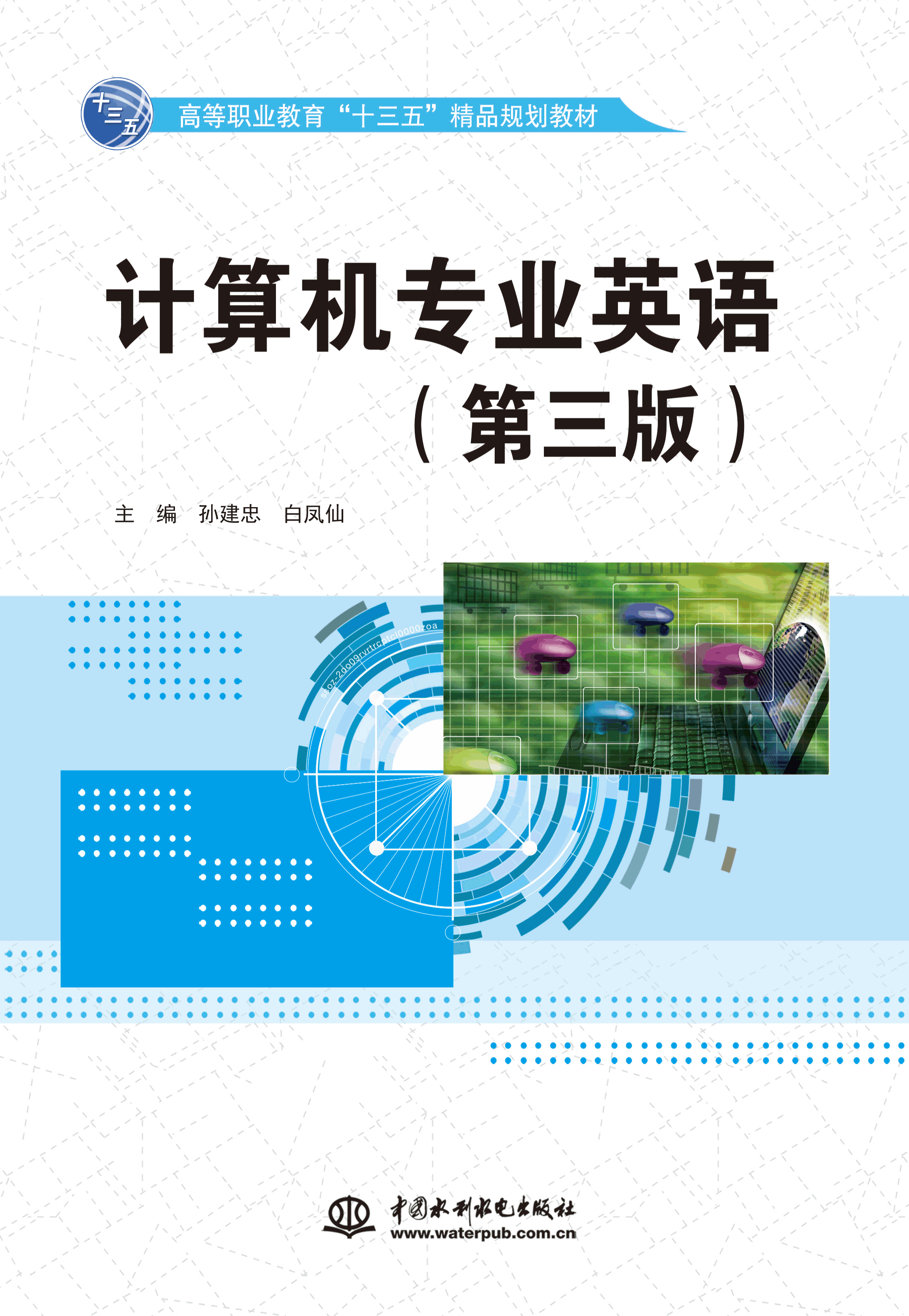計算機專業英語(第三版)

-
【作 者】孫建忠 白鳳仙
【I S B N 】978-7-5170-4660-8
【責任編輯】楊慶川
【適用讀者群】本專通用
【出版時間】2016-12-09
【開 本】16開
【裝幀信息】平裝(光膜)
【版 次】第1版第1次印刷
【頁 數】232
【千字數】361
【印 張】14.5
【定 價】¥28
【叢 書】高等職業教育“十三五”精品規劃教材
【備注信息】
簡介
本書特色
前言
章節列表
精彩閱讀
下載資源
相關圖書
本書以計算機和網絡技術為背景,對計算機英語進行了全面的描述。全書涉及計算機的歷史與發展、計算機的組成結構、數據結構、操作系統、軟件工程、計算機語言、因特網、萬維網、網絡與安全、物聯網、云計算、數據庫管理系統、多媒體和動畫等14個主題,并介紹計算機技術與應用的一些最新發展。
本書所選材料語言規范、內容新穎、完整實用。每一章均包括:學習指導與小結、課文、注釋與譯文、閱讀材料、練習與專業英語專題等內容。專業英語專題包括計算機詞匯及其構成規律、科技英語的閱讀與翻譯技巧、科技論文及其摘要的寫作、商業書信以及日常求職英語等必備知識。
本書可作為高職高專計算機專業的專業英語教材,也可作為使用計算機的廣大科技工作者的參考書。
本書配有電子教案,讀者可以從中國水利水電出版社網站和萬水書苑免費下載,網址為:http://www.waterpub.com.cn/softdown/和http://www.dgboyong.cn。
本書以計算機和網絡技術為背景,對計算機英語進行了全面的描述專業英語專題包括計算機詞匯及其構成規律、科技英語的閱讀與翻譯技巧、科技論文及其摘要的寫作、商業書信以及日常求職英語等必備知識
每一章均包括學習指導與小結、課文、注釋與譯文、閱讀材料、練習與專業英語專題等內容,語言精練,內容實用,穿插案例,圖文并茂,易學易懂易用
免費提供電子教案等教學資源
今天,人類已經進入了“互聯網+”時代,物聯網,云計算,大數據,人類正在迎來又一次信息產業浪潮。地球村的出現打破了傳統的時空觀念,使人們與外界乃至整個世界的聯系更為緊密。由于諸多原因,國際上最通用的語言還是英語;而因特網的普及,更鞏固了英語作為跨文化交往通用語言的地位。因此,為了掌握最新的信息技術,了解信息技術的發展動向,必須具備較高的英語水平。本書的編寫目的,首先是讓學生掌握計算機專業英語的基本術語,了解一些計算機專業的基本知識;其次是為了介紹信息技術的一些最新發展。
本書以計算機與網絡技術為背景,充分考慮了計算機英語的復雜性和新穎性,針對高職高專的教學特點,精心組織,合理選材。主要內容包括:計算機的歷史與發展、計算機的組成結構、數據結構、操作系統、軟件工程、計算機語言、因特網、萬維網、網絡與安全、數據庫管理系統、多媒體、動畫、物聯網和云計算等的基本概念等共14章。
本書為第3版,第1、2版受到了廣大讀者的關心和支持,熱心的讀者還專為第1版課文提供了部分譯文,借本書第3版出版的機會對廣大讀者的支持再次表示衷心的感謝。
根據教材的使用情況及計算機技術的發展,對本書進行了修訂。在延續第1、2版編寫風格的基礎上,對教材內容進行了更新,刪去了一些過時的內容,增加了反映計算機技術和信息技術發展水平的新內容;全書按照計算機基礎、計算機網絡與計算機應用三個部分進行了組織;考慮到學生的實際需要,系統而扼要地介紹了計算機詞匯構成規律、科技英語的閱讀與翻譯技巧、科技論文及其摘要的寫作以及求職英語和廣告英語的特點;為了便于教學,還附有參考譯文。
本書由大連理工大學孫建忠、白鳳仙主編,主要編寫人員具體分工為:第1、2、3、13、14章由孫建忠編寫,第4、5、6、7章由程立編寫,第8、9、10、11、12章由白鳳仙和姚衛紅編寫。參加本書編寫的還有李若芬、周龍、秦世宏、李智、李梅、劉翌南、李琳等。
由于作者水平有限,編寫時間倉促,本書在編寫過程中難免出現疏漏,懇請讀者不吝賜教,郵件地址:sjzbfx@163.com。
編 者
2016年8月
學習指導 1
1.1 The Invention of the Computer 1
1.1.1 The ENIAC 1
1.1.2 The UNIVAC I 2
1.2 Computer Generations 2
1.2.1 First-Generation Computers: 1951~1958 3
1.2.2 Second-Generation Computers: 1959~1963 3
1.2.3 Third-Generation Computers: 1964~1970 4
1.2.4 Fourth-Generation Computers:1971~? 4
1.2.5 Generationless Computers 5
Reading Material: Classes of Computing Applications and Their Characteristics 6
科技英語的特點 7
Exercises 10
Chapter 2 Basic Organization of Computers 11
學習指導 11
2.1 Introduction 11
2.2 System Buses 12
2.3 Instruction Cycle 13
2.4 CPU ORGANIZATION 15
Reading Material: Eight Great Ideas in Computer Architecture 17
計算機英語專業詞匯的構成 19
Exercises 23
Chapter 3 Binary System and Boolean
Algebra 24
學習指導 24
3.1 The Decimal System 24
3.2 The Binary System 26
3.3 Boolean Algebra 26
數學公式的讀法(Pronunciation of mathematical expressions) 28
Exercises 31
Chapter 4 Elementary Data Structures 32
學習指導 32
4.1 Stacks and queues 32
4.1.1 Stacks 32
4.1.2 Queues 33
4.2 Linked lists 35
4.2.1 Searching a linked list 36
4.2.2 Inserting into a linked list 36
4.2.3 Deleting from a linked list 36
4.2.4 Sentinels 37
Reading Material: Related Concepts 38
常用英漢互譯技巧 40
Exercises 45
Chapter 5 Operating System 46
學習指導 46
5.1 OS Functions 46
5.1.1 Resource allocation and related
functions 46
5.1.2 User interface related functions 48
5.2 FreeBSD vs. Linux vs. Windows 2000 49
Reading Material: RATs 52
被動語態的譯法 54
Exercises 57
Chapter 6 Software Engineering 58
學習指導 58
6.1 Basic Software Concepts 58
6.1.1 Application Software 59
6.1.2 System Software 59
6.2 The Software Life Cycle 60
6.2.1 System engineering and analysis 61
6.2.2 Software requirements analysis 61
6.2.3 Design 61
6.2.4 Coding 61
6.2.5 Testing 61
6.2.6 Maintenance 62
6.3 Prototyping 63
Reading Material: Software Engineering Methodologies 64
長定語(從句)的翻譯技巧之一 66
Exercises 69
Chapter 7 Programming Language 70
本章學習指導 70
7.1 Introduction to Programming Language 70
7.2 Object-oriented Programming 72
7.3 OMG's Unified Modeling Language(UML) 73
Reading Material: Programming Paradigms 75
長定語(從句)的翻譯技巧之二 78
Exercises 81
Chapter 8 The Internet 82
學習指導 82
8.1 The Internet: Key Technology Concepts 82
8.2 Other Internet Protocols and Utility
Programs 88
8.3 Internet Service Providers 89
Reading Material: Transition from IPv4 to IPv6 91
英語長句的翻譯 92
Exercises 96
Chapter 9 The World Wide Web 97
學習指導 97
9.1 Hypertext 97
9.2 Markup Languages 98
9.3 Web Servers and Clients 100
9.4 Web Browsers 101
Reading Material: Features of The Internet and
The Web 102
學術論文的英文寫作簡介 107
Exercises 109
Chapter 10 Network Security 110
學習指導 110
10.1 Secure Networks and Policies 110
10.2 Aspects of Security 111
10.3 Responsibility and Control 111
10.4 Integrity Mechanism 111
10.5 Access Control and Passwords 112
10.6 Encryption and Privacy 112
10.7 Public Encryption 113
10.8 Authentication with Digital Signatures 114
10.9 Packet Filtering 115
10.10 Internet Firewall Concept 116
Reading Material: KINDS OF SECURITY BREACHES 117
科技論文標題的寫法 118
Exercises 120
Chapter 11 Database System 121
學習指導 121
11.1 Overview 121
11.2 Database Models 123
11.2.1 Flat File 123
11.2.2 Relational 123
11.2.3 Hierarchical 124
11.2.4 Other Database Models 125
11.3 Data Mining 126
英文論文引言的寫作技巧 127
Exercises 134
Chapter 12 Multimedia and Compuer
Animations 135
學習指導 135
12.1 Multimedia 135
12.1.1 Visual Elements 136
12.1.2 Sound Elements 136
12.1.3 Organizational Elements 137
12.1.4 Multimedia Applications 137
12.2 Computer Animation 138
12.2.1 Design of Animation Sequences 138
12.2.2 General Computer-Animation
Functions 139
英文摘要的寫作技巧 140
Exercises 144
Chapter 13 Anatomy of the Internet of Things 145
學習指導 145
13.1 Traditional Internet Protocols Aren’t the Solution for Much of the IoT 146
13.1.1 Introducing the “Chirp” 146
13.1.2 Functionality the IoT Needs—and Doesn’t 147
13.1.3 Efficiency Out of Redundancy 148
13.2 It’s All Relative 150
13.2.1 Format Flexibility 151
13.2.2 Private Markers for Customization and Extensibility 151
13.2.3 Addressing and “Rhythms” 152
13.2.4 Family Types 152
13.3 Applying Network Intelligence at Propagator Nodes 153
13.3.1 Transport and Functional Architectures 154
13.3.2 Functional Network Topology 156
13.3.3 Defined by Integrator Functions 156
13.3.4 Harvesting Information from the IoT 157
13.3.5 Programming and “Bias” 157
13.3.6 Receiver-Oriented Selectivity 158
求職英語簡介 159
Exercises 162
Chapter 14 Cloud Computing 163
學習指導 163
14.1 Definitions 163
14.2 Related Technologies for Cloud
Computing 165
14.3 Cloud Service Models 168
14.4 Cloud Deployment Models 169
14.5 Public Cloud Platforms: State-of-the-Art 170
14.6 Business Benefits of Cloud Computing 172
廣告文體簡介 173
Exercises 176
參考譯文 177
參考文獻 226
- 輸水管線工程風險管理 [張勇 黨亥生 著]
- 民用航空飛機標準線路施工 [主編 王志敏 陳明]
- 不息的水脈—大運河講談錄 [趙珩 著]
- 實用運籌學 [主編 邢育紅 于晉臣]
- 三峽梯級電站水資源決策支持系統研究與開發 [姚華明 潘紅忠 湯正]
- 海南黎族民俗文化鑒賞 [龐國華 著]
- 石墨烯在太赫茲及中紅外頻段電磁器件設計中的應用 [李艷秀 莊華偉 著]
- 電子技術(第二版) [主編 覃愛娜 李飛]
- 辦公自動化高級應用 [陳萍 朱曉玉]
- 信息處理技術員考試32小時通關 [薛大龍]
- 電子產品設計案例教程(微課版)—基于嘉立創EDA(專業版) [王靜 莫志宏 陳學昌 丁紅]
- C程序設計實踐教程 [劉衛國]
- C程序設計(慕課版) [劉衛國]
- Web技術開發教程(基于.NET開源MVC框架) [王合闖 韓紅玲 王青正 陳海蕊]
- 商務英語翻譯教程(筆譯)(第四版) [主編 王軍平]
- 智慧零售技術與應用 [洪旭 著]
- 建設工程法規實務 [主編 余瀅]
- 商務秘書理論與實務(第三版) [主編 張同欽]
- 程序設計基礎實踐教程(C/C++語言版) [張桂芬 葛麗娜]
- C++案例項目精講 [主編 楊國興]
- 勞動爭議處理實務 [主編 王秀卿 羅靜]
- 工程數學 [主編 郭立娟 王海]
- 語音識別理論與實踐 [主編 莫宏偉]
- 信息系統項目管理師章節習題與考點特訓(第二版) [主編 薛大龍]
- 武術基礎教程 [主編 李代勇 謝志民]
- 計算機網絡實訓教程 [主編 張浩軍 趙玉娟]
- 畫法幾何與機械制圖習題集(多學時) [主編 趙軍]
- HCIA-Datacom認證題庫分類精講 [主 編 韓立剛]
- SwiftUI完全開發 [李智威 著]
- 網絡規劃設計師備考一本通 [夏杰 編著]

